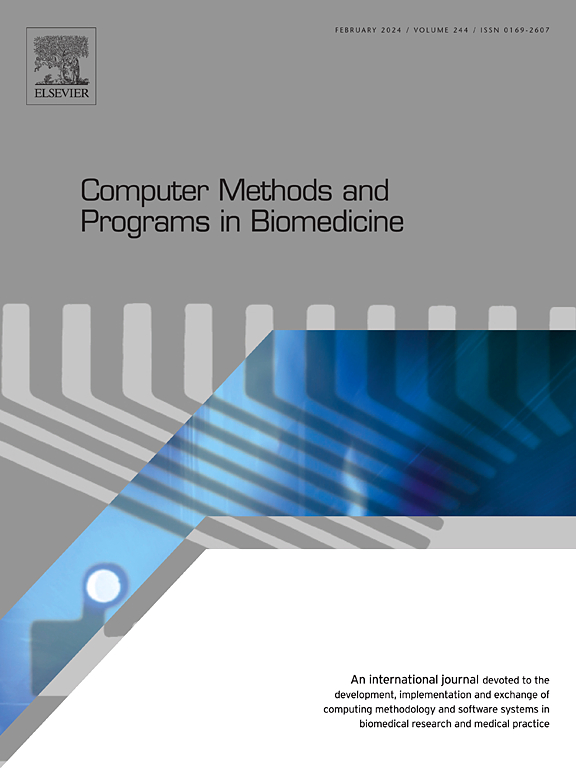结合数值模拟和体外实验的解剖和近壁血流动力学特征预测腹主动脉瘤腔内修复术后髂肢体闭塞
IF 4.9
2区 医学
Q1 COMPUTER SCIENCE, INTERDISCIPLINARY APPLICATIONS
引用次数: 0
摘要
背景与目的髂肢体闭塞(iliac limb occlusion, ILO)是腹主动脉瘤(AAA)血管内动脉瘤修复(EVAR)的严重并发症,多数需要及时再干预。本研究旨在结合解剖学和近壁血流动力学特征,探讨ILO的发病机制、危险因素及预测模型。方法AAA级EVAR患者75例(闭塞25例;纳入通畅性50例。基于体外实验验证的数值模拟,对evar前和evar后早期解剖(近端颈部角度、半径、曲率、扭转和扭曲度)和近壁血流动力学参数(时间平均壁剪切应力[TAWSS]、振荡剪切指数[OSI]和相对停留时间[RRT])进行量化。从未闭塞与未闭塞患者的差异、EVAR的影响以及闭塞与未闭髂动脉(IAs)的不对称性三个角度对ILO的原因进行统计分析。提出了一个新的参数EVAR (DRE)或IAs (DRI)的差比来评价EVAR和双边IAs之间不对称引起的变化程度。结果闭塞组evar前TAWSS (p = 0.004)高于未闭塞组(p = 0.033);在evar后早期,未来闭塞IA的OSI和RRT明显高于IA。闭塞IA组evar前与evar后早期RRT的差比(RRT的DRE)也高于未闭塞IA组(p = 0.025)。结合解剖学和近壁血流动力学变量建立了ILO预测模型(曲线下面积= 0.924),其中evar前OSI DRI的比值比最高,为5.45 (1.77 ~ 16.74,p = 0.003), evar前外IA半径的比值比最低,为0.06 (0.01 ~ 0.45,p = 0.007)。结论EVAR前的高TAWSS和大扭转,以及EVAR (DRE)导致的RRT过度增加可能诱发ILO。evar前双侧IAs (DRI)之间OSI的高度不对称和evar前外部IAs的较小半径与ILO风险增加显著相关。以上研究结果可以为预测和降低劳工组织风险提供一定的理论指导。本文章由计算机程序翻译,如有差异,请以英文原文为准。
Prediction of iliac limb occlusion after endovascular aneurysm repair for abdominal aortic aneurysm by anatomical and near-wall hemodynamic characteristics combining numerical simulation and in vitro experiment
Background and Objective
Iliac limb occlusion (ILO) is a serious complication of endovascular aneurysm repair (EVAR) for abdominal aortic aneurysm (AAA), and most require timely reintervention. The study aims to explore pathogenesis, risk factors and prediction models of ILO combining anatomical and near-wall hemodynamic characteristics.
Methods
75 AAA patients with EVAR (occlusion 25; patency 50) were included. Pre-EVAR and early post-EVAR anatomical (proximal neck angulation, radius, curvature, torsion and tortuosity) and near-wall hemodynamic parameters (time-averaged wall shear stress [TAWSS], oscillatory shear index [OSI] and relative residence time [RRT]) were quantified based on numerical simulation validated through in vitro experiment. The causation of ILO was investigated statistically in three perspectives: differences between patent and occluded patients, effect of EVAR and asymmetries between occluded and patent iliac arteries (IAs). A new parameter, the difference ratio of EVAR (DRE) or IAs (DRI), was proposed to evaluate the degree of changes caused by EVAR and asymmetries between bilateral IAs.
Results
The occluded patients had higher TAWSS (p = 0.004) and larger torsion of common IA (p = 0.033) at pre-EVAR than patent patients. At early post-EVAR, OSI and RRT of future occluded IA were significantly higher than patent IA. The difference ratio of pre-EVAR and early post-EVAR RRT (DRE of RRT) on occluded IA was also higher than that on patent IA (p = 0.025). A prediction model for ILO (area under curve = 0.924) was developed combining anatomical and near-wall hemodynamic variables, where DRI of pre-EVAR OSI had the highest odds ratio [OR] of 5.45 (1.77‒16.74, p = 0.003), and pre-EVAR radius of external IA had the lowest OR of 0.06 (0.01‒0.45, p = 0.007).
Conclusions
High TAWSS and large torsion at pre-EVAR, and excessive increase in RRT by EVAR (DRE) might induce ILO. Higher asymmetry of pre-EVAR OSI between bilateral IAs (DRI) and smaller radius of pre-EVAR external IA were significantly associated with increased ILO risk. The above findings can provide some theoretical guidance to predict and reduce the risk of ILO.
求助全文
通过发布文献求助,成功后即可免费获取论文全文。
去求助
来源期刊

Computer methods and programs in biomedicine
工程技术-工程:生物医学
CiteScore
12.30
自引率
6.60%
发文量
601
审稿时长
135 days
期刊介绍:
To encourage the development of formal computing methods, and their application in biomedical research and medical practice, by illustration of fundamental principles in biomedical informatics research; to stimulate basic research into application software design; to report the state of research of biomedical information processing projects; to report new computer methodologies applied in biomedical areas; the eventual distribution of demonstrable software to avoid duplication of effort; to provide a forum for discussion and improvement of existing software; to optimize contact between national organizations and regional user groups by promoting an international exchange of information on formal methods, standards and software in biomedicine.
Computer Methods and Programs in Biomedicine covers computing methodology and software systems derived from computing science for implementation in all aspects of biomedical research and medical practice. It is designed to serve: biochemists; biologists; geneticists; immunologists; neuroscientists; pharmacologists; toxicologists; clinicians; epidemiologists; psychiatrists; psychologists; cardiologists; chemists; (radio)physicists; computer scientists; programmers and systems analysts; biomedical, clinical, electrical and other engineers; teachers of medical informatics and users of educational software.
 求助内容:
求助内容: 应助结果提醒方式:
应助结果提醒方式:


